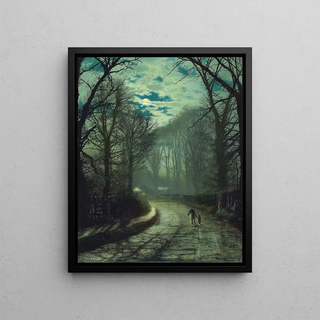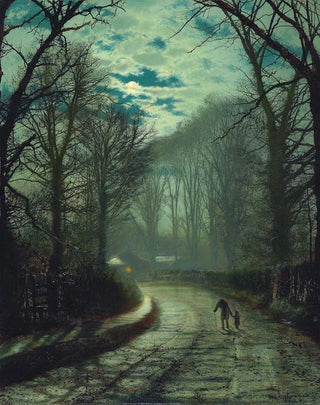Art print | Near the house - John Atkinson Grimshaw


View from behind

Frame (optional)
In the fascinating world of Victorian art, "Près de la maison - John Atkinson Grimshaw" stands out for its captivating atmosphere and delicate light. This art print, which captures a fleeting moment at dusk, invites the viewer to immerse themselves in a scene filled with poetry and melancholy. Grimshaw, master of chiaroscuro, manages to transform a simple landscape into a rich visual experience, where every detail seems to tell a story. The shades of blue and gold blending in the twilight sky evoke a disturbing serenity, while the silhouette of a house, barely illuminated, rises as a symbol of refuge and contemplation. This art print of the work allows appreciation of the artist's technical finesse while offering a window into a bygone era, where nature and architecture coexisted in harmony.
Style and uniqueness of the work
Grimshaw's style is characterized by meticulous attention to detail and masterful use of light. In "Près de la maison," the composition is carefully orchestrated to guide the viewer's gaze across the painting. The majestic trees frame the scene, while the soft light emanating from the sky and the house's windows creates a striking contrast with the surrounding shadow. This duality between light and darkness is one of Grimshaw's signatures, who manages to capture not only the beauty of the landscape but also an atmosphere imbued with emotion. Reflections on the water, textures of foliage, and architectural details testify to his exceptional talent. Every element, from the smallest to the largest, is carefully considered to contribute to the harmony of the whole, making this art print a true celebration of nature and humanity.
The artist and his influence
John Atkinson Grimshaw, born in 1836 in Leeds, is often regarded as one of the greatest representatives of the Pre-Raphaelite movement and Victorian realism. His career, marked by a constant stylistic evolution, leads him to develop a unique visual language that combines romanticism and precision. Influenced by the masters of Flemish painting and by British landscapes

Matte finish

View from behind

Frame (optional)
In the fascinating world of Victorian art, "Près de la maison - John Atkinson Grimshaw" stands out for its captivating atmosphere and delicate light. This art print, which captures a fleeting moment at dusk, invites the viewer to immerse themselves in a scene filled with poetry and melancholy. Grimshaw, master of chiaroscuro, manages to transform a simple landscape into a rich visual experience, where every detail seems to tell a story. The shades of blue and gold blending in the twilight sky evoke a disturbing serenity, while the silhouette of a house, barely illuminated, rises as a symbol of refuge and contemplation. This art print of the work allows appreciation of the artist's technical finesse while offering a window into a bygone era, where nature and architecture coexisted in harmony.
Style and uniqueness of the work
Grimshaw's style is characterized by meticulous attention to detail and masterful use of light. In "Près de la maison," the composition is carefully orchestrated to guide the viewer's gaze across the painting. The majestic trees frame the scene, while the soft light emanating from the sky and the house's windows creates a striking contrast with the surrounding shadow. This duality between light and darkness is one of Grimshaw's signatures, who manages to capture not only the beauty of the landscape but also an atmosphere imbued with emotion. Reflections on the water, textures of foliage, and architectural details testify to his exceptional talent. Every element, from the smallest to the largest, is carefully considered to contribute to the harmony of the whole, making this art print a true celebration of nature and humanity.
The artist and his influence
John Atkinson Grimshaw, born in 1836 in Leeds, is often regarded as one of the greatest representatives of the Pre-Raphaelite movement and Victorian realism. His career, marked by a constant stylistic evolution, leads him to develop a unique visual language that combines romanticism and precision. Influenced by the masters of Flemish painting and by British landscapes






